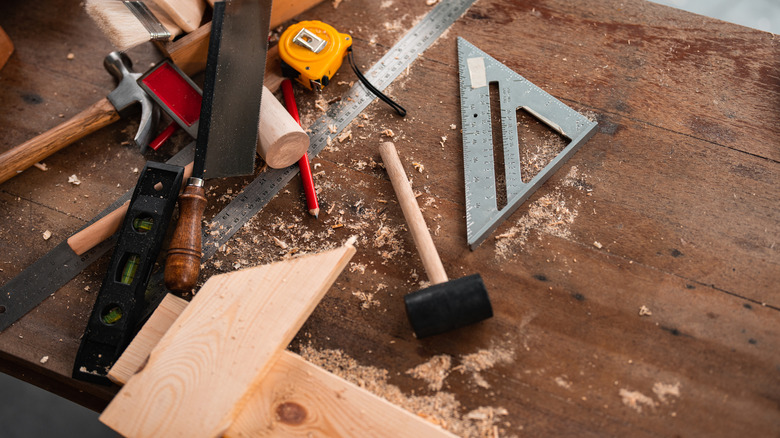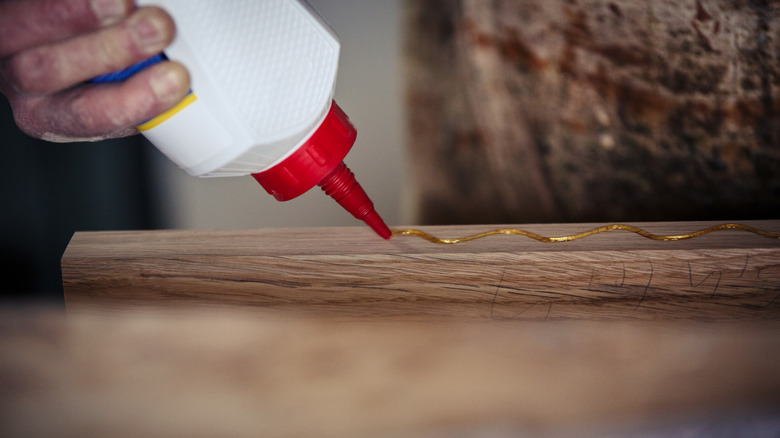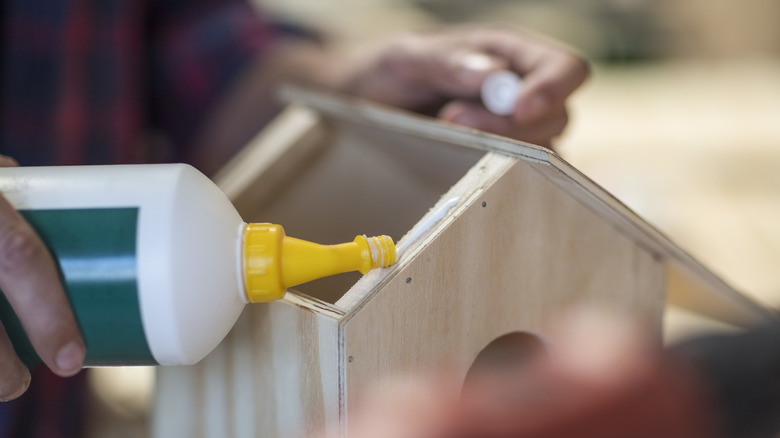Does Polyurethane Construction Adhesive Work Well For Woodworking Projects? Here's What We Know
We may receive a commission on purchases made from links.
For many, polyurethane glues like the Original Gorilla Glue are a household stable. These adhesives have become one of the main glues to keep on hand due to their ability to bond a range of materials including glass, concrete, carpet, and more. However, if you're looking for a construction adhesive for your intricate woodworking projects, polyurethane may be more trouble than it's worth. Instead, consider sticking to wood-specific glues like polyvinyl acetates.
Polyurethane glues refer to adhesives made from polymer or long chain molecules. Thanks to their strength and versatility, these adhesives have become popular amongst contractors for a variety of jobs. But that doesn't mean they need to be your go-to for woodworking. As our internal expert carpenter and remodeler Bob Beacham exclusively told House Digest, "The argument some make [for using polyurethane on glue] is that it's stronger than the wood it bonds. That may be true, but so are most adhesives."
One thing to keep in mind about polyurethane glues is that they're quite messy partially due to their thick, rubbery texture. As Beacham attests, "The ones that I have used are quite sticky ... [Okay] when applying runs with a caulk gun but difficult to manage over small areas." While these adhesives may work for rustic furniture, he notes that "if you try to use it on intricate joints (box, dovetail, mortise and tenon), it will get everywhere and end up making a real mess." Plus, if you get any excess glue on your project, it can be a real headache because polyurethane stains are difficult to remove from wood.
Adhesive alternatives for intricate woodworking projects
If you're dead-set on using polyurethane for woodworking, Beacham exclusively told House Digest that wood-specific glues are available. While these products are strong, they still come with the downsides of general polyurethane adhesives. He points out that polyurethane wood glue still "foam[s] out of the joint, so cleanup is more difficult." Additionally, these strong adhesives "stick to just about anything," Beacham notes, so, "this does make them hard to clean off your hands or tools if you get on them."
While polyurethane may not be ideal for many woodworking projects, there are other wood glues to choose from. As Beacham tells House Digest, "Modern [polyvinyl acetates] are just as flexible in terms of application temperature, and waterproof versions are available (though I don't know why you'd need that with intricate woodworking)."
Often referred to as white glue, polyvinyl acetates are excellent for porous materials like wood and paper. While the term polyvinyl acetate might not ring a bell, you've likely grown up using it. One of the most common types of polyvinyl acetates around is Elmer's Glue All. For wood glue, though, they are yellow or tan instead of white. In Beacham's experience, Titebond has been a brand worth returning to, and Gorilla Wood Glue (which shouldn't be confused with Original Gorilla Glue) is also good to use.
The benefits of using polyvinyl acetate glues for woodworking
There are many benefits to using polyvinyl acetates for your woodworking projects. One of its main strengths is that it sinks into the fibers of your wood, which makes a very strong bond. In addition, these glues don't really give off fumes, and they are safe to handle with your hands. Since they are non-toxic, you also don't have to worry as much if you have kids or pets around.
Once applied, Beacham exclusively tells House Digest that you can sand polyvinyl acetates. For woodworking specifically, he also notes that, "One of the big benefits ... is that they have a relatively thin consistency." You may often find bottles with fine nozzles for accurate application but you can also brush these glues on.
Overall, wood-specific glues will make your day much easier than polyurethane adhesives. When using wood glue for your project, keep in mind that polyvinyl acetates typically take 18 to 24 hours to cure. However, you can follow these tips to better determine (and even speed up) drying time. During the first hour of curing, you may also want to use a clamp on the bond to help the adhesive properly set. And if you have any existing glue that seems like it's gotten too thick to use, don't throw it out or buy more. Instead, you may be able to save your old wood glue with a kitchen staple.


